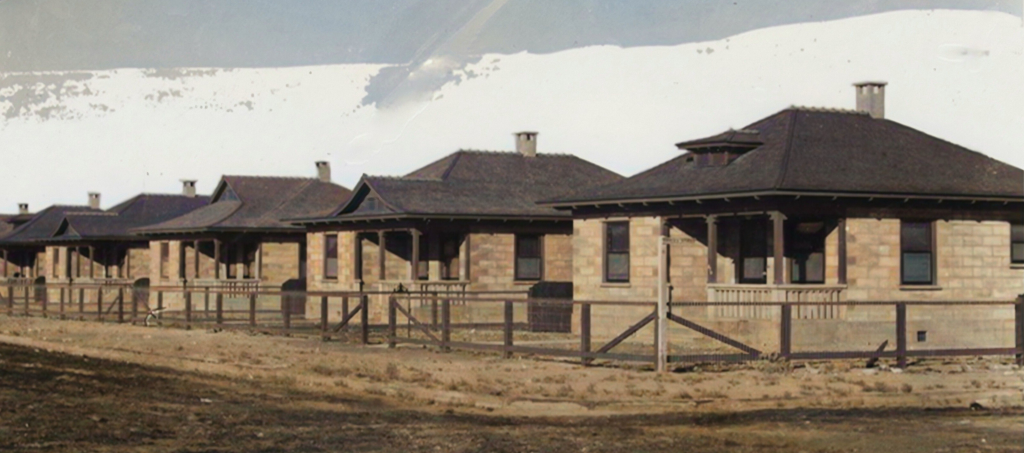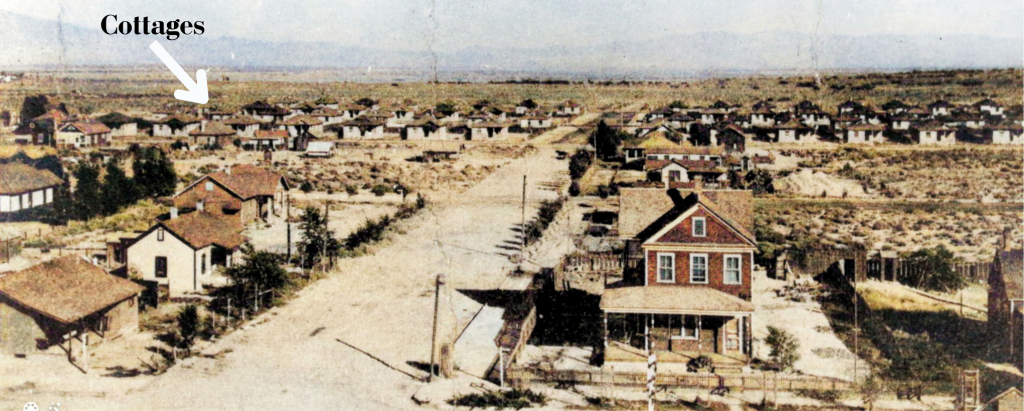
Michelle Munkres, MA, ELS
Michelle Munkres, MA, ELS, is a Las Vegas-based editor and content strategist. In her personal time, she volunteers with the Clark County Museum Guild to help preserve Southern Nevada’s stories. She currently leads the Guild’s efforts to relocate Howard Hughes’s historic Green House to Heritage Street.
As settlers and railroad developers moved west in the early 20th century, the Las Vegas and southern Nevada landscape began to transform. Among the first symbols of this transformation were the Las Vegas Railroad Cottages: a cluster of small homes built by the San Pedro, Los Angeles & Salt Lake Railroad to house its employees. These cottages are among the earliest residential developments in Las Vegas and offer a rare lens into the early decades of a rapidly evolving city.
Westward Expansion & Railway Beginnings
The railroad played a pivotal role in shaping the American West, enabling efficient transport of people, goods, and capital across once-isolated regions. In southern Nevada, the arrival of the San Pedro, Los Angeles & Salt Lake Railroad brought with it the infrastructure necessary for lasting settlement, including water rights, rail access, and job opportunities. The industry’s need for division points (i.e., locations for refueling, maintenance, and crew changes) transformed key stops along the line into new towns, including Las Vegas.
Las Vegas, situated near natural springs and between Salt Lake City and Los Angeles, emerged as a strategic location for a division point. Recognizing this potential, Senator William Andrews Clark, a powerful Montana copper baron and financier of the railroad, purchased land in the valley and secured water access essential to development. In 1905, his company auctioned lots that became Clark’s Las Vegas Townsite. Although Clark would soon cede control of the railroad to Union Pacific, the frameworks he established, including the Las Vegas Land & Water Company, laid the foundation for civic growth. The Las Vegas Railroad Cottages, initiated a few years later, were one of the earliest and most enduring results of this effort to transform a remote outpost into a permanent town.
Building a Model Neighborhood (1909–1911)
Between 1909 and 1911, Las Vegas Land & Water Company (the railroad’s land subsidiary) built 64 cottages in a four-block area just south of the railyards. Company plans, at one point, suggested building as many as 120 cottages, but development stopped at 64 cottages by June 1911, likely adjusting to demand and resources. The cottages were built from standardized designs for efficiency and were an early example of tract housing.
In fact, this development is noted as Las Vegas’s first subdivision.

Photo of early residential development, courtesy UNLV Special Collections
There were two main layouts: a five-room, three-bedroom plan (about 812 sq ft) and a four-room, two-bedroom plan (around 768 sq ft). Despite the repetitive floor plans, the railroad offered a bit of visual variety by using three different facade styles (noted as types A, B, and C) and exposed rafters and modest eaves, helping prevent the streetscape from appearing entirely uniform.
Blueprints for the homes and the neighborhood grid are available via UNLV Special Collections.
Architecturally, the railroad cottages can be described as simple Bungalow/Craftsman-style, specifically “pyramidal roof cottages” common to the era. Each was a single-story house with a low-pitched hipped roof and a small porch.
Unusual for Nevada (and the period in general), the cottages were constructed of concrete masonry, not wood. Lumber was expensive to import to the desert, so the railroad made concrete blocks (cinder blocks) on-site using local sand and molds; even window sills were poured concrete. This material choice had practical benefits: thick masonry walls helped interiors stay cooler in searing summers and retain warmth on winter nights.
Before the cottages, many railroad men lived in canvas tent-houses: wood platforms and short sidewalls with tents on top, offering scant comfort or protection from the elements. The new cottages, by comparison, were luxury: solid floors, actual windows, and separate rooms for cooking, living, and sleeping.
Lease-to-Own: Paying for a Railroad Cottage
The Las Vegas railroad cottages were not simply free housing or casual rentals; they were offered under a program innovative for the time. Employees who moved into these homes did so on a “lease by purchase” basis (basically, a rent-to-own agreement) managed by the Las Vegas Land & Water Company. Under this arrangement, workers paid a fixed monthly fee that functioned as both rent and an installment toward ownership.
According to company records, a four-room cottage cost about $20.00 per month in rent, while the larger five-room cottage was about $22.50 per month. Adjusted for inflation, this is approximately $727 to $818 in 2025.
Over the span of the lease, an employee would ultimately pay around four times the actual construction cost of the home, a fact the railroad acknowledged. Even so, the premium helped encourage stability and eventual ownership — a rare opportunity for working-class families in that period.
The railroad made it as easy as possible for workers to make these payments. Walter R. Bracken, the local land agent overseeing the program, coordinated a system of payroll deductions so that the rent-purchase payments came directly out of employees’ paychecks. The company even went so far as to initially advance property taxes on the homes and then recover those costs by adding a small surcharge (around 10%) to the monthly payments, ensuring that new homeowners weren’t overburdened by annual tax bills.
This paternalistic but pragmatic approach stemmed from the railroad’s philosophy: helping employees acquire homes was believed to improve morale and root the workforce in the community. In 1925, one executive wrote that “it is this Company’s purpose to assist its employees in acquiring homes on easy terms,” cautioning that it would be “rather harsh” to change policies in ways that hurt these wage-earning homeowners (Board of Directors correspondence, 1925). Each cottage, then, was not just a residence but part of an early corporate housing experiment.
Life in the Railroad Cottage Community
By design, the railroad cottages fostered a close-knit community of railroad workers. Occupants were skilled employees who relocated to Las Vegas to work the expanding railroad operations around 1909. Soon after the cottages were built, conductors, engineers, brakemen, and even a railroad surgeon moved in; these residents represented the upper tier of local railroad labor, as they were not executives but instead key staff, leadership, and foremen needed to run a division point. Their presence signaled Las Vegas was transitioning from a tent camp to a town with a permanent, family-oriented population.

Neighborhood children at a lemonade stand in a railroad cottage neighborhood, circa 1930. Courtesy UNLV Special Collections.
Life in the cottage district had a wholesome, small-town character. Many families took pride in their cottages. They tended yards and even attempted lawns. Neighbors knew each other, and the workforce’s families formed the nucleus of early Las Vegas society with church picnics, school outings, and baseball games on empty lots all within walking distance of the cottages.
Despite the relative modernity of these homes, residents still faced challenges typical of a frontier town. Municipal infrastructure lagged behind the railroad’s development. There was no city sewer system in 1910, so each cottage relied on a cesspool or outhouse; foul odors and the occasional cesspool collapse were unpleasant realities until Las Vegas installed proper sewers years later.
Sidewalks were another luxury that arrived later. Initially, the cottage blocks had none, so people simply walked along the dirt shoulders of the road. To keep down dust, the unpaved streets and alleys were periodically rolled and oiled, a common practice in early Las Vegas.
Inside the cottages, the thick masonry walls moderated the temperature, but without insulation or modern air conditioning, families adapted their routines to the climate. One former resident, George Garner (born 1923), later recounted that during the peak of summer his family would sleep outside on the screened porch, catching night breezes, and in winter they often all camped in the living room near the stove, since the bedrooms could be uncomfortably chilly.
Legacy and Relocation
The railroad cottages proved to be foundational for Las Vegas’s development. The cottage district’s establishment in 1909-1911 bookended two milestone events: the creation of Clark County in 1909 and Las Vegas’s incorporation as a city in 1911. The influx of railroad families living in the cottages boosted the town’s population and economy, contributing to its ability to self-govern and grow, prompting growth in schools, churches, and other residential essentials.
This was the city’s first real neighborhood: a planned residential tract that brought order and “modern” living to what had been a patch of sagebrush.
Over the decades, as Las Vegas boomed in other directions, the modest cottages downtown eventually aged out of use or were eclipsed by commercial development. By the mid-20th century, many had been converted to offices or demolished as the city’s center transitioned from residential to business uses. Preservation was an afterthought in fast-growing Vegas, and by 1985 only about 35 of the original 64 cottages were still standing.
Fortunately, efforts were made to save some of these historic homes.
In 1987, a cluster of eight cottages was listed on the National Register of Historic Places as the “Railroad Cottage Historic District.” When that block was slated for redevelopment in the 2000s, preservationists arranged to relocate several cottages rather than see them destroyed.
In the early 2000s, one cottage (originally at 521 S. 3rd St.) was donated and moved to the Clark County Museum, where it was restored and opened as a public exhibit in 2013.
A few years later, four cottages were moved to the Las Vegas Springs Preserve, where they form a centerpiece of the “Boomtown 1905” historical streetscape.
Today, only a handful of the old railroad cottages survive on their original lots, notably one at S. Casino Center Boulevard, now repurposed as a law office and said to be the oldest house in Las Vegas still in its place.
The Las Vegas railroad cottages may be humble in appearance, but their legacy looms large. They remind us that Las Vegas was built on the unassuming cottages of railroad workers. These little houses tell the story of early Las Vegas: a story of corporate ambition and community building, of families carving out a life in a harsh environment, and of a railroad’s faith in a town that would one day far exceed everyone’s expectations.
References & Resources
- Clark County Museum, Railroad Cottage exhibit panel clarkcountynv.govclarkcountynv.gov.
- Noble, Brent. “Here’s the story of the oldest houses left in Las Vegas.” Las Vegas Review-Journal, 15 July 2024 reviewjournal.comreviewjournal.comreviewjournal.com.
- Kachelriess, Rob. “Railroad Cottages in Downtown Las Vegas.” City Cast Las Vegas, 21 June 2024 lasvegas.citycast.fmlasvegas.citycast.fm.
- Railroad Cottage Historic District, National Register of Historic Places Registration Form (1987) en.wikipedia.orgen.wikipedia.org.
- UNLV Special Collections, Photograph of children and their lemonade stand in Las Vegas, 1932 (Elizabeth Harrington Collection) special.library.unlv.eduspecial.library.unlv.edu.
- Nevada Historical Society Quarterly, “Cottages of Las Vegas, Then and Now” (Winter 1984) epubs.nsla.nv.govepubs.nsla.nv.gov.
- PBS American Experience. “William Andrews Clark.” PBS.org, 2008 pbs.org.
